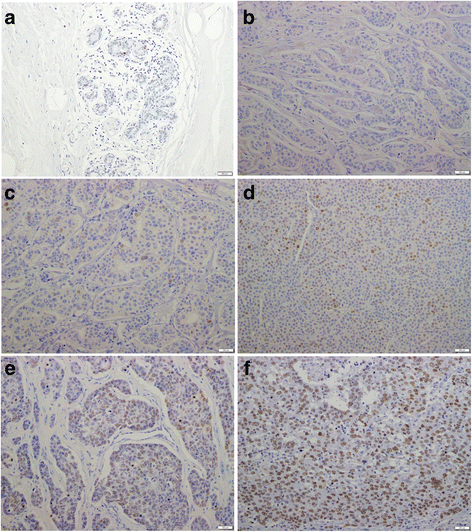Expression of enhancer of zeste homolog 2 correlates with survival outcome in patients with metastatic breast cancer: exploratory study using primary and paired metastatic lesions
- PMID: 28241804
- PMCID: PMC5330119
- DOI: 10.1186/s12885-017-3154-3
Expression of enhancer of zeste homolog 2 correlates with survival outcome in patients with metastatic breast cancer: exploratory study using primary and paired metastatic lesions
Abstract
Background: In metastatic breast cancer, the status of the estrogen receptor (ER), progesterone receptor (PR), and human epidermal growth factor receptor 2 (HER2), as well as the Ki-67 index sometimes change between primary and metastatic lesions. However, the change in expression levels of enhancer of zeste homolog 2 (EZH2) between primary and metastatic lesions has not been determined in metastatic breast cancer.
Methods: Ninety-six metastatic breast cancer patients had biopsies or resections of metastatic lesions between September 1990 and February 2014 at the Kanagawa Cancer Center. We evaluated ER, PR, HER2, Ki-67, and EZH2 in primary lesions and their corresponding metastatic lesions using immunohistochemistry. We examined the change in expression of EZH2 between primary and metastatic lesions, the correlation between the expression of EZH2 and the expression of other biomarkers, and the relationship between EZH2 expression and patient outcome in metastatic breast cancer.
Results: EZH2 expression was significantly higher in metastatic lesions compared with primary lesions. EZH2 expression was highly correlated with Ki-67 expression in primary and metastatic lesions. High-level expression of EZH2 was associated with poorer disease-free survival (DFS) outcomes in patients with primary lesions (P < 0.001); however, high-level expression of EZH2 was not associated with poorer DFS outcomes in patients with metastatic lesions (P = 0.063). High-level expression of EZH2 was associated with poorer overall survival (OS) postoperatively in patients with primary (P = 0.001) or metastatic lesions (P = 0.005). High-level expression of EZH2 was associated with poorer OS outcomes after recurrence in patients with metastatic lesions (P = 0.014); however, high-level expression of EZH2 was not associated with poorer OS outcomes after recurrence in patients with primary lesions (P = 0.096). High-level expression of EZH2 in metastatic lesions was independently associated with poorer OS outcomes after recurrence.
Conclusions: EZH2 expression was significantly increased in metastatic lesions compared with primary lesions. High-level expression of EZH2 in metastatic lesions was associated with poorer OS outcomes after primary surgery and recurrence.
Keywords: EZH2; Epigenetics; Immunohistochemistry; Ki-67; Metastatic breast cancer; Prognostic factor.
Figures



Similar articles
-
Clinicopathological and prognostic significance of Ki-67 immunohistochemical expression of distant metastatic lesions in patients with metastatic breast cancer.Breast Cancer. 2017 Nov;24(6):748-755. doi: 10.1007/s12282-017-0774-z. Epub 2017 Apr 19. Breast Cancer. 2017. PMID: 28425014
-
[Expression discordances and clinical values of ER, PR, HER-2 and Ki-67 in primary and metastatic breast cancer].Zhonghua Zhong Liu Za Zhi. 2019 Sep 23;41(9):681-685. doi: 10.3760/cma.j.issn.0253-3766.2019.09.007. Zhonghua Zhong Liu Za Zhi. 2019. PMID: 31550858 Chinese.
-
Aberrant expression of enhancer of zeste homologue 2, correlated with HIF-1α, refines relapse risk and predicts poor outcome for breast cancer.Oncol Rep. 2014 Sep;32(3):1101-7. doi: 10.3892/or.2014.3322. Epub 2014 Jul 10. Oncol Rep. 2014. PMID: 25017254
-
Clinical and prognostic relevance of EZH2 in breast cancer: A meta-analysis.Biomed Pharmacother. 2015 Oct;75:218-25. doi: 10.1016/j.biopha.2015.07.038. Epub 2015 Aug 10. Biomed Pharmacother. 2015. PMID: 26271144 Review.
-
Enhancer of zeste homolog 2 expression is associated with metastasis and adverse clinical outcome in clear cell renal cell carcinoma: a comparative study and review of the literature.Arch Pathol Lab Med. 2013 Oct;137(10):1326-36. doi: 10.5858/arpa.2012-0525-OA. Arch Pathol Lab Med. 2013. PMID: 24079759 Review.
Cited by
-
Epigenetic Dysregulation at the Crossroad of Women's Cancer.Cancers (Basel). 2019 Aug 16;11(8):1193. doi: 10.3390/cancers11081193. Cancers (Basel). 2019. PMID: 31426393 Free PMC article. Review.
-
Clinicopathological Analysis of Expression of Enhancer of Zeste Homologue 2 in Canine Mammary Carcinoma.J Vet Res. 2022 Jul 5;66(2):267-272. doi: 10.2478/jvetres-2022-0033. eCollection 2022 Jun. J Vet Res. 2022. PMID: 35892097 Free PMC article.
-
MUC1-C activates polycomb repressive complexes and downregulates tumor suppressor genes in human cancer cells.Oncogene. 2018 Apr;37(16):2079-2088. doi: 10.1038/s41388-017-0096-9. Epub 2018 Jan 30. Oncogene. 2018. PMID: 29379165 Free PMC article. Review.
-
Prognostic Factors in Hormone Receptor-Positive/Human Epidermal Growth Factor Receptor 2-Negative (HR+/HER2-) Advanced Breast Cancer: A Systematic Literature Review.Cancer Manag Res. 2021 Aug 20;13:6537-6566. doi: 10.2147/CMAR.S300869. eCollection 2021. Cancer Manag Res. 2021. PMID: 34447271 Free PMC article. Review.
-
Differential expressions of PD-1, PD-L1 and PD-L2 between primary and metastatic sites in renal cell carcinoma.BMC Cancer. 2019 Apr 16;19(1):360. doi: 10.1186/s12885-019-5578-4. BMC Cancer. 2019. PMID: 30992011 Free PMC article.
References
-
- Rahman ZU, Frye DK, Smith TL, Asmar L, Theriault RL, Buzdar AU, Hortobagyi GN. Results and long term follow-up for 1581 patients with metastatic breast carcinoma treated with standard dose doxorubicin-containing chemotherapy: a reference. Cancer. 1999;85:104–111. doi: 10.1002/(SICI)1097-0142(19990101)85:1<104::AID-CNCR15>3.0.CO;2-R. - DOI - PubMed
Publication types
MeSH terms
Substances
LinkOut - more resources
Full Text Sources
Other Literature Sources
Medical
Research Materials
Miscellaneous

